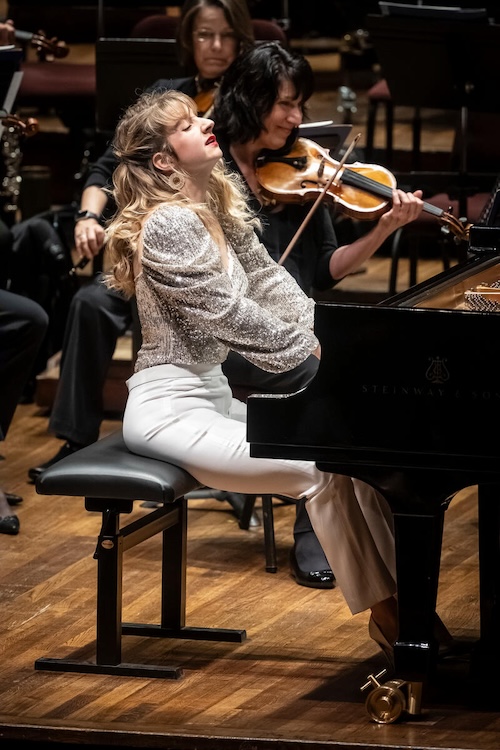Young impressively leads NSO in kaleidoscopic works by Strauss and Saariaho

Simone Young led the National Symphony Orchestra in music of Strauss, Mozart and Saariaho Thursday night at the Kennedy Center. Photo: Scott Suchman
Simone Young, a globetrotting veteran maestro who is currently chief conductor of the Sydney Symphony Orchestra in her native Australia, came halfway around the world to lead the National Symphony Orchestra on Thursday night in the Kennedy Center Concert Hall. The cleverly balanced program featured two lush works for huge orchestras by Kaija Saariaho and Richard Strauss, with a piano concerto by Wolfgang Amadeus Mozart to cleanse the palate in between.
First performed in 2002 by the Cleveland Orchestra, Saariaho’s Orion has been widely performed since and will likely enter the standard repertoire, assuming orchestral budgets can pay for the necessary materiel—the score calls for an organ, a piano, two harps, and 19 other percussion instruments, among others. Saariaho marshals these forces with precision and subtlety, so that gradual changes in timbre or texture feel monumental, like a new face of a mountain coming into view.
The first movement, titled “Memento mori,” opened with misty, hypnotic harmonies, beautifully rendered by the NSO. A melodic line eventually started snaking through them, finding its way tentatively at first but growing more assured. The rhythmic pulse stayed steady Thursday under Young’s expert direction, and the music built inexorably to a huge climax that shattered to reveal only the low murmur of the organ below it all.
Carole Bean unfurled a gorgeous, birdsong-like melody high on her piccolo to begin the second movement, “Winter Sky,” after which concertmaster Nurit Bar-Josef gave the motif another arresting rendition before passing it to other winds. The musical landscape around the melody, however, felt tense and treacherous, even as the melody continued to refract and change. An arresting texture of high notes from piano, harp, and strings suggested sun-scoured earth at the end.
“The Hunter,” the third movement, put us into the chase, with flashing instrumental colors and lots of kinetic energy; Young, helping guide the orchestra’s energy. The only time the intensity let up was at the close, when two of the percussionists began swinging whistling tubes to make an otherworldly sound (the tubes were bright blue and hot pink, sparking some titters from the audience). Still, an exceptional performance by Young and the NSO of a truly compelling work, one best appreciated in live performance.

Lise de la Salle performed Mozart’s Piano Concerto No., 9 with the NSO Thursday night. Photo: Scott Suchman
Lise de la Salle joined Young and the NSO for Mozart’s Piano Concerto No. 9, known as the “Jeunehomme.” The string section, much reduced from the Saariaho, had a little trouble getting in sync at first, and de la Salle’s playing sounded routine in passagework; the first movement really came to life during the cadenza, whose Romantic qualities de la Salle emphasized with imaginative phrasing and a loose approach to tempo. The dark, intense slow movement came off better, with de la Salle’s playing again most vivid when stretching out melodic lines to expressive ends. She romped through the Presto finale, enjoying its virtuoso challenges, and the NSO provided fine support.
For an encore, de la Salle selected Franz Schubert’s “An die Musik,” saying, “I would like to dedicate this piece to a better world and peace in the world.” Her Schubert had a light touch but still glowed with an inner radiance—a different sound world from the Mozart, one in which she seemed more at home.
Young made her name in part as a conductor of German opera — indeed, later this year she will become the first woman to conduct Richard Wagner’s Ring cycle at Bayreuth—and she showed her facility with Strauss’ instrumental idiom in Also sprach Zarathustra, which closed the program.
In the opening “Dawn,” the orchestra made a radiant outburst of timpani and brass, but didn’t linger; Young allowed the music to blossom but also maintained a sense of urgency for Friederich Nietzche’s philosophical explorations. Young made sure to draw out the hero’s motif from “Dawn” as it recurred throughout, making it a kind of observer in “Of the Backwoodsmen” and “The Convalescent.”
The orchestra played with rapt intensity in the keening melodies of “Of Great Yearning” and “Of Joys and Passions,” and in “Of Science,” the fugue came in a great tangible rumble from the low strings. An enormous chime tolled imposingly during Strauss’ final section, “Song of the Night Wanderer,” after which Young and the orchestra brought the work to its haunting, unsettled close.
The program will be repeated 8 p.m. Saturday. kennedy-center.org

